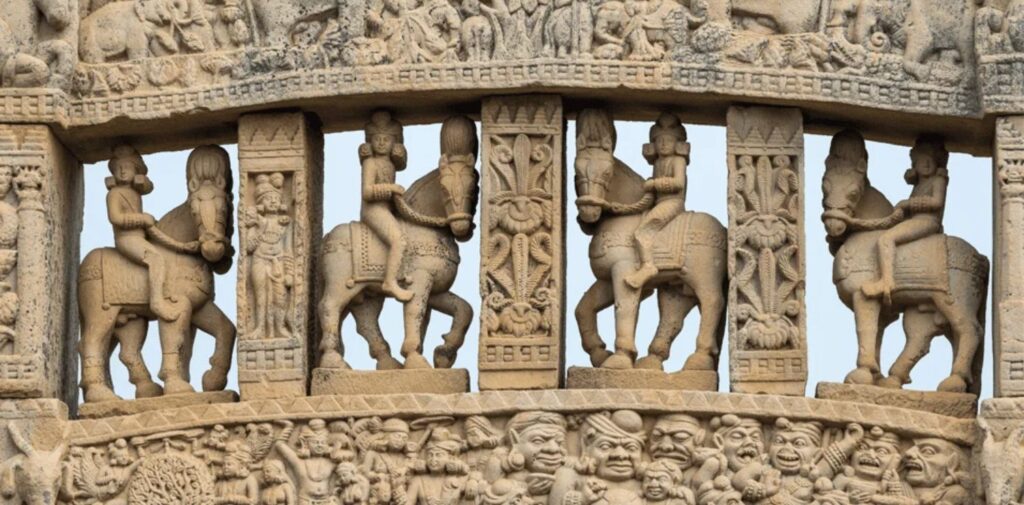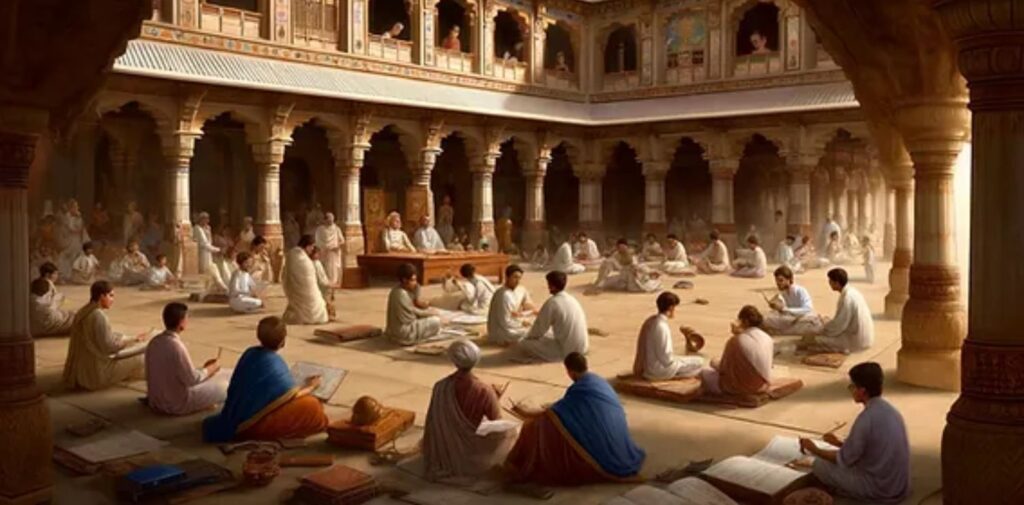The Gupta Empire, which flourished in India from around the 4th to the 6th century CE, is often referred to as the “Golden Age of India.” It was a period marked by great achievements in science, mathematics, literature, and art. While the Gupta Empire’s influence on Indian culture is well-known, its impact extended far beyond the subcontinent, particularly influencing the art and culture of Southeast Asia. This article explores how the Influence of the Gupta Empire on Southeast Asia in terms of artistic expression, architecture, religion, and cultural practices.
Historical Context of the Gupta Empire
The Gupta Empire, under rulers like Chandragupta I, Samudragupta, and Chandragupta II, is considered one of the most prosperous and influential empires in Indian history. The empire’s reach, which included vast parts of northern India, allowed for cultural and intellectual advancements that had a profound effect on neighboring regions, particularly Southeast Asia.
During the Gupta period, there was significant progress in fields such as astronomy, mathematics, literature, and religion. The Gupta rulers were strong patrons of art, encouraging the creation of stunning sculptures, architecture, and religious imagery. The trade routes between India and Southeast Asia, along with the spread of Hinduism and Buddhism, helped the exchange of cultural and artistic ideas across the region.

Influence on Art and Architecture
One of the most lasting impacts of the Gupta Empire on Southeast Asia was in the realm of art and architecture. Gupta art, known for its graceful and highly refined style, found its way into Southeast Asia, especially in the regions that had strong connections with India.
- Architectural Styles: The Gupta period saw the development of distinctive architectural features, particularly in the construction of temples and sculptures. The Indian architectural style, characterized by intricate carvings, large pillars, and domed structures, influenced temple architecture in Southeast Asia. The famous temples of Angkor Wat in Cambodia and Borobudur in Indonesia, both of which were built centuries after the Gupta period, show clear evidence of Gupta-inspired architectural features. In addition to these larger structures, smaller shrines and temples across Southeast Asia, particularly in places like Thailand, Cambodia, and Vietnam, display sculptural elements and designs that trace their roots back to Gupta-era India. The influence is evident in the symmetry, grandeur, and style of the temple constructions.
- Sculptural Influence: Gupta sculptures, especially those depicting gods, goddesses, and mythological figures, are known for their elegance and naturalism. These artistic qualities were transmitted to Southeast Asia, where they influenced the creation of similar sculptures in local temples. For example, in Cambodia, the famous sculptures of Buddha and Hindu deities found in temples like Angkor Wat bear distinct stylistic similarities to the Gupta sculptures, with smooth, flowing lines, and well-defined features. The Gupta style of depicting the human form in a graceful and idealized manner influenced Southeast Asian artists to adopt similar methods of representation.
- Iconography and Symbolism: The Gupta Empire was a period of religious flourishing, with both Hinduism and Buddhism making significant advancements. Many Gupta-era sculptures and artworks were focused on religious themes, depicting deities, gods, and symbols associated with these religions. These religious symbols found their way to Southeast Asia, where the depiction of Hindu gods like Vishnu, Shiva, and Brahma, as well as Buddhist figures like Buddha and bodhisattvas, became prominent in local art and culture. For example, the Borobudur Temple in Indonesia is a magnificent example of Gupta influence, with its bas-reliefs and statues showcasing Buddhist teachings, much like those created in India during the Gupta period.

Religious Influence: Spread of Hinduism and Buddhism
The Gupta Empire played a crucial role in the spread of Hinduism and Buddhism beyond the borders of India, especially into Southeast Asia. The Gupta rulers were great patrons of both religions, and their influence helped shape the religious landscape of Southeast Asia.
- Hinduism in Southeast Asia: The Gupta period saw the flourishing of Hinduism in India, and this influence was carried to Southeast Asia through trade, cultural exchanges, and political relationships. Indian traders, priests, and scholars traveled to Southeast Asia, spreading Hindu philosophies, rituals, and temple practices. Hindu rulers and elites in Southeast Asia adopted many aspects of Indian culture, including religion, language, and art. Hindu deities like Shiva and Vishnu became prominent in Southeast Asian religious practices. Temples dedicated to these deities were constructed in places like Java (Indonesia), Cambodia, and Thailand, showing the deep influence of Indian religious traditions. For instance, the Prambanan Temple in Indonesia, which was built in the 9th century, is a remarkable example of the continued influence of Gupta-era Hindu architecture and religious themes. The temple complex, dedicated to the Trimurti (the three principal deities: Brahma, Vishnu, and Shiva), reflects the Gupta style of temple design and Hindu iconography.
- Buddhism’s Influence: Buddhism, which had also flourished under the Gupta Empire, spread to Southeast Asia through similar routes. The Gupta rulers were supporters of Buddhism, and the artistic depictions of the Buddha, as well as Buddhist symbolism, were carried to Southeast Asia by missionaries and traders. The most notable example of Buddhist influence is the Borobudur Temple in Indonesia. Built in the 9th century, this massive Buddhist temple complex is one of the greatest monuments of Southeast Asia. The architectural design and reliefs at Borobudur show clear parallels with Gupta Buddhist art, such as the depiction of the Buddha in various poses and the use of narrative reliefs to illustrate Buddhist teachings.
Literary and Cultural Influence
In addition to religious and artistic influence, the Gupta Empire’s contributions to literature and culture also spread to Southeast Asia. Ancient Indian texts like the Mahabharata, Ramayana, and Puranas became well-known in Southeast Asia, where they were either adopted or adapted into local traditions. The Mahabharata and Ramayana were particularly important in shaping the cultural and literary traditions of Southeast Asian countries such as Thailand, Cambodia, and Indonesia.
- Epics in Southeast Asia: In places like Thailand and Cambodia, the Ramayana was adapted into local versions known as the Ramakien and Reamker, respectively. These adaptations retained many of the themes, characters, and moral teachings from the Indian original, highlighting the enduring influence of Gupta literature and mythology on Southeast Asia.
- Sanskrit Influence on Language: The Gupta period also saw the development of Sanskrit as a language of administration and culture. Through trade and religious exchange, Sanskrit had a significant influence on the languages of Southeast Asia. Many words, phrases, and literary traditions in Thai, Khmer, Malay, and Javanese are derived from Sanskrit.

Cultural Exchange and Trade Networks
The spread of Gupta art and culture to Southeast Asia was facilitated through extensive trade networks. The Indian Ocean trade routes connected India with Southeast Asia, allowing for the exchange of goods, ideas, and cultural practices. Indian traders and cultural ambassadors traveled frequently between the two regions, carrying with them not only luxury goods but also religious, artistic, and philosophical ideas.
Through these networks, Indian traders played an essential role in the transmission of Gupta cultural elements. The Srivijaya Empire in Indonesia, for instance, became an important center for the spread of both Hinduism and Buddhism, with Indian influences apparent in the region’s architecture, sculpture, and religious practices.
Conclusion: Influence of the Gupta Empire
The Gupta Empire, with its rich cultural and religious achievements, left an indelible mark on Southeast Asia. The art, architecture, and religious traditions of the Gupta period spread far beyond India, influencing the cultures of Southeast Asia for centuries. Whether through the construction of grand temples, the spread of Hindu and Buddhist teachings, or the adaptation of Indian epics and literary forms, the Gupta Empire’s cultural legacy remains an important part of Southeast Asia’s history.
Today, the influence of the Gupta Empire can still be seen in the religious practices, architectural structures, and cultural traditions of countries like Cambodia, Indonesia, Thailand, and Vietnam. The Gupta period truly laid the foundation for the shared cultural and spiritual heritage between India and Southeast Asia, a relationship that continues to thrive today.




